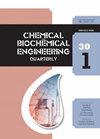Enhanced Removal of Cr(VI) from Aqueous Solutions Using Poly(Pyrrole)-g-Poly(Acrylic Acid-co- Acrylamide)/Fe3O4 Magnetic Hydrogel Nanocomposite Adsorbent
IF 0.9
4区 生物学
Q4 BIOTECHNOLOGY & APPLIED MICROBIOLOGY
引用次数: 5
Abstract
In the present work, the structural characterization and chromium adsorption behavior of a novel poly(pyrrole)-based magnetic hydrogel nanocomposite (MHN) is reported. This product was prepared using free-radical copolymerization of pyrrole (Py), acrylic acid (AA) and acrylamide (AM) monomers, and subsequent in situ synthesis of magnetic Fe3O4 nanoparticles. The structure of MHNs was then characterized by FTIR, SEM, TEM, XRD, UV-Vis and VSM techniques, and a mechanism for the preparation of MHNs is also proposed. The maximum Cr(VI) adsorption capacity (208 mg g–1) was achieved under the optimum conditions that were found to be: AA = 0.25 mol L–1, AM = 1.2 mol L–1, agitation time = 90 min, solution pH = 1.0, ion concentration = 100 mg L–1, adsorbent dose = 50 mg, and temperature = 65 °C. Further, the calculated values of the thermodynamic parameters (ΔH° = 31.33kJ mol–1, ΔS° = 105.67 J K–1 mol–1, ΔG° = –61.33 kJ mol–1) revealed that ion adsorption is a spontaneous and endothermic process. In general, the results indicated that the synthesized MHNs with specific properties can be used in wastewater treatment applications.聚(吡咯)-g-聚(丙烯酸-丙烯酰胺)/Fe3O4磁性水凝胶纳米复合吸附剂对水溶液中Cr(VI)的去除效果研究
本文报道了一种新型聚吡咯基磁性水凝胶纳米复合材料(MHN)的结构表征和对铬的吸附行为。该产品采用吡咯(Py)、丙烯酸(AA)和丙烯酰胺(AM)单体自由基共聚制备,随后原位合成磁性纳米Fe3O4。采用FTIR、SEM、TEM、XRD、UV-Vis和VSM等技术对MHNs的结构进行了表征,并提出了MHNs的制备机理。在AA = 0.25 mol L-1, AM = 1.2 mol L-1,搅拌时间= 90 min,溶液pH = 1.0,离子浓度= 100 mg L-1,吸附剂剂量= 50 mg,温度= 65℃的条件下,吸附Cr(VI)的最大吸附量为208 mg g-1。热力学参数(ΔH°= 31.33kJ mol-1, ΔS°= 105.67 jk - 1 mol-1, ΔG°= -61.33 kJ mol-1)的计算值表明,离子吸附是一个自发的吸热过程。综上所述,合成的MHNs具有一定的性能,可用于污水处理。
本文章由计算机程序翻译,如有差异,请以英文原文为准。
求助全文
约1分钟内获得全文
求助全文
来源期刊
CiteScore
2.70
自引率
6.70%
发文量
23
审稿时长
>12 weeks
期刊介绍:
The journal provides an international forum for presentation of original papers, reviews and discussions on the latest developments in chemical and biochemical engineering. The scope of the journal is wide and no limitation except relevance to chemical and biochemical engineering is required.
The criteria for the acceptance of papers are originality, quality of work and clarity of style. All papers are subject to reviewing by at least two international experts (blind peer review).
The language of the journal is English. Final versions of the manuscripts are subject to metric (SI units and IUPAC recommendations) and English language reviewing.
Editor and Editorial board make the final decision about acceptance of a manuscript.
Page charges are excluded.

 求助内容:
求助内容: 应助结果提醒方式:
应助结果提醒方式:


